Security
Security Risks
The security risk widget shows the total number of security risk recommendations for various resources across all providers. By clicking on the number of security risk recommendations, users can access data and further recommendations for addressing those risks. These recommendations are displayed in accordance with the security risk recommendation that was clicked. This feature can be helpful for organizations looking to improve their cybersecurity posture and protect their resources from potential threats.
High Risks
The high-risks widget displays high-level security risk recommendations for various resources. By clicking on the number of security risk recommendations, users can view data and further recommendations for addressing those risks. These recommendations are displayed in accordance with the security risk recommendation that was clicked. This feature can help organizations prioritize their efforts to address the most serious security risks and improve their overall cybersecurity posture.
Medium Risks
The medium risks widget displays medium-level security risk recommendations for various resources. By clicking on the number of security risk recommendations, users can view data and further recommendations for addressing those risks. These recommendations are displayed in accordance with the security risk recommendation that was clicked. This feature can help organizations prioritize their efforts to address security risks that are not as severe as high-level risks but still require attention.
Low Risks
The low-risks widget displays lower-level security risk recommendations for various resources. By clicking on the number of security risk recommendations, users can view data and further recommendations for addressing those risks. These recommendations are displayed in accordance with the security risk recommendation that was clicked. This feature can help organizations prioritize their efforts to address security risks that are less severe than medium or high-level risks, but still need to be addressed to maintain a strong cybersecurity posture.

Recommendations
The recommendation widget shows all recommendations across all providers, including AWS, GCP, and Azure. This feature allows users to view a comprehensive list of recommendations for optimizing their use of resources and reducing costs across all providers.
You can select multiple rows by checking their respective checkboxes, and you also have the choice to mute all recommendations simultaneously using the select actions.
When you select the number of rows, you will be able to view that same quantity of rows on the page.

The recommendation table allows you to sort, search, and download the recommendations. You can also use the settings icon to change the way the recommendations are displayed in the user interface. The recommendations will be displayed according to the selected view. This feature provides users with flexibility and control over how they access and view the recommendations, making it easier for them to find and use the information they need.
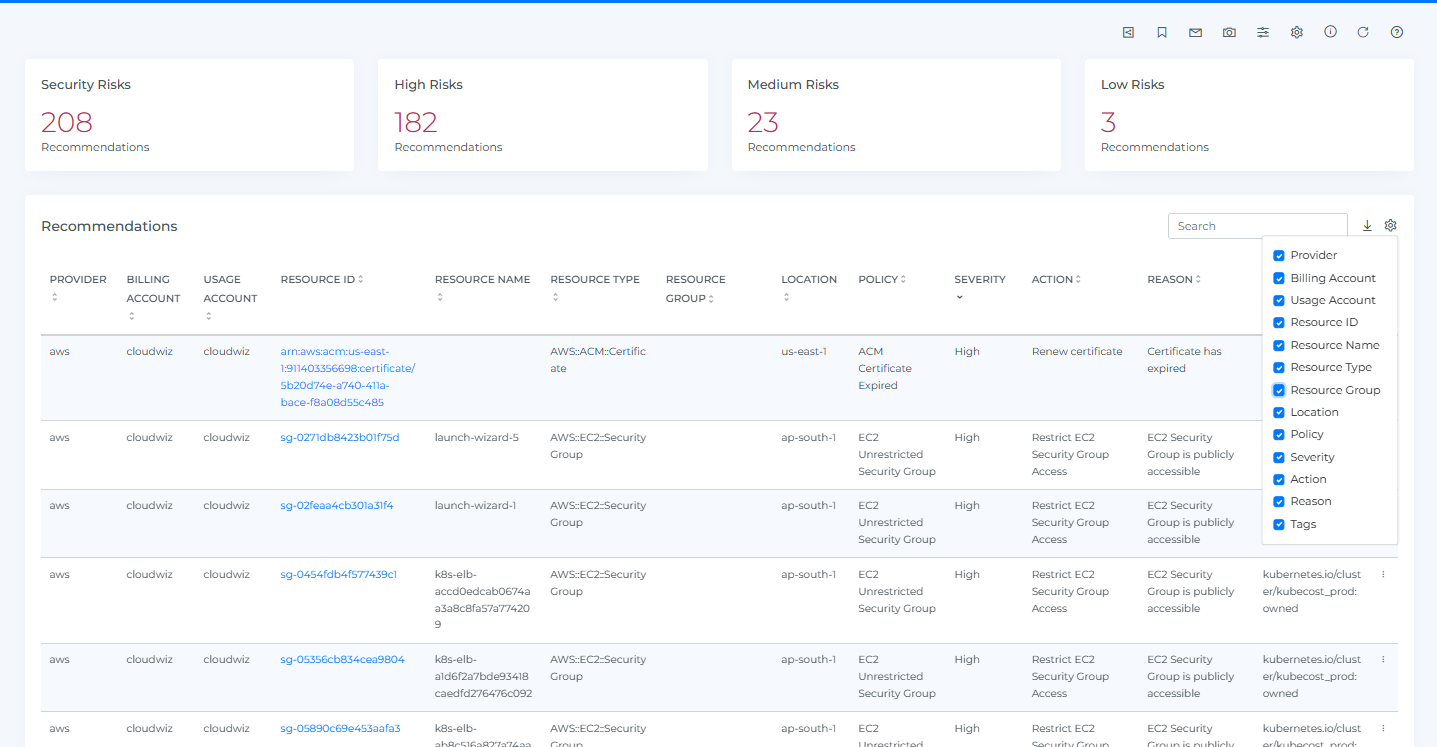
To access the Resource details, for that particular resource just click on the three dots located in the right corner of the resource, and then select "View Details." This information can help you understand more about the resource.
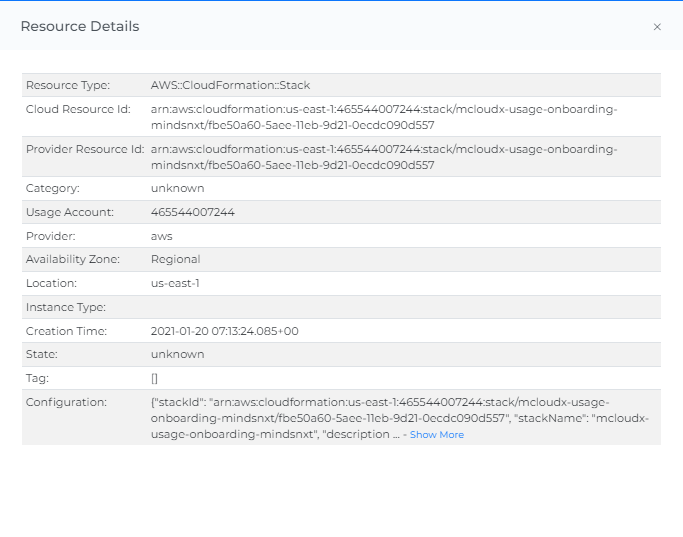
Create / Update Ticket
To initiate the ticket creation process for that specific resource, simply click the three dots in the resource's upper right corner and choose "Create Ticket." If you've previously generated a ticket, you will find the "Update Ticket" option available.
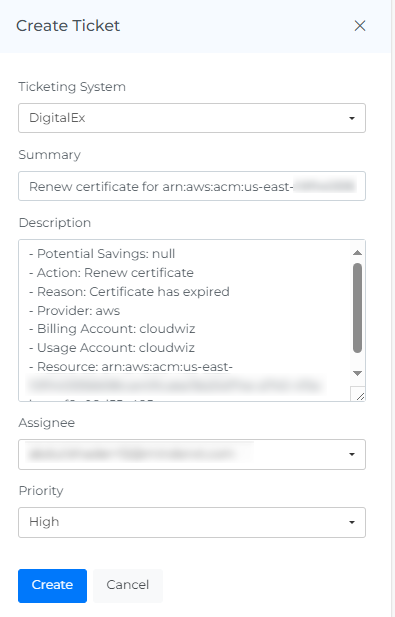
You can also generate multiple tickets at once by selecting multiple checkboxes.

Mute/Unmute Resources
To begin muting specific resources, click on the three dots located in the upper right corner of the resource. From the menu that appears, select the "Mute" option. If you have muted these resources before, you will see the option to "Unmute."
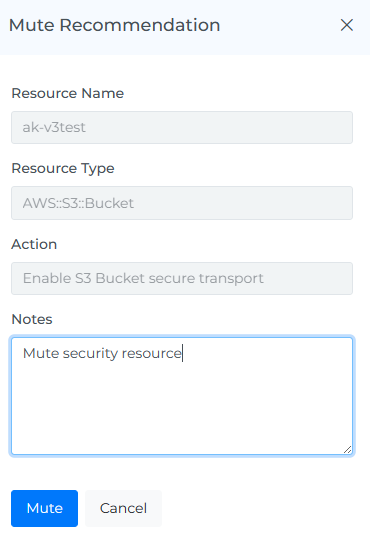
You can also mute multiple items at once by selecting their checkboxes.

Metrics
The monitoring graphs (Metrics) for different provider services allow users to see the usage and performance of these resources over time. By clicking on the three dots in the corner of the resource instance, users can access the metrics for that particular instance and change the metric type and intervals using the drop-down menu. They can also strikethrough to manage the statistics and hover the mouse over the dots on the line graph to see usage data for daily and hourly intervals. If the daily interval is selected, users can set the date range up to the last 30 days. This type of information can be useful for understanding how resources are being used and for identifying any potential issues or opportunities for optimization.
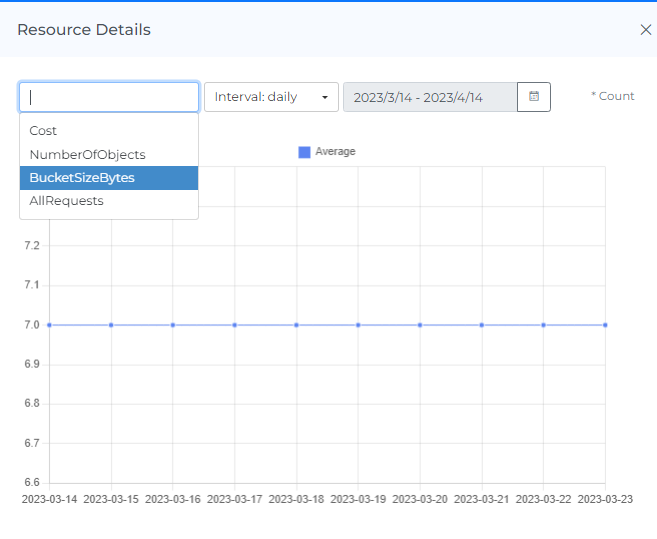
Share
If you click on the "share" link, a link to the current page will be copied to your clipboard. You can then share this link with other team members, allowing them to access the same data and filters as you. This can be useful for collaborating with others and sharing information about your Security Page.
Security Filters
Basic
The filter option allows you to narrow down the data displayed on the page to specific criteria. You can use the filter to view Security Page for a particular Billing Account, usage Account, Location, resource type & severity. This can help you focus on specific aspects of your Security recommendations and more effectively analyze and understand the data.
On selecting Dynamic Filter adjusts options based on previous selections. For example, choosing a Provider will update subsequent filters (e.g., Billing Account, Resource Type) to show only relevant data for that provider. This ensures efficient and context-sensitive filtering.
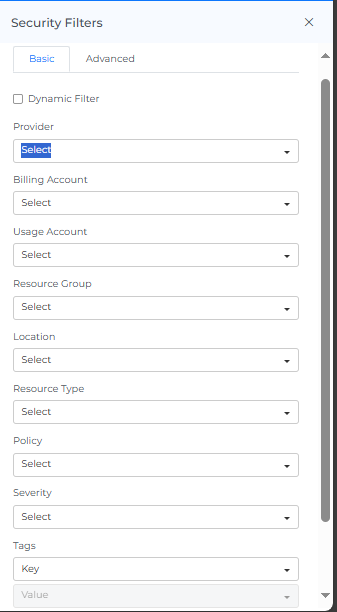
Advance
The "Advanced Security Filters" feature use to apply detailed filters to refine search results. You can add multiple filters by selecting criteria like "Provider," choosing an operator (e.g., "IN"), and selecting values from dropdown menus. The interface includes options to apply or cancel changes and a "Clear All" button to reset filters.

Screenshot
If you click on the camera icon, you can take a screenshot of the current page and download it as a PDF file. This can be useful for saving a copy of the data or for sharing it with others.
Security Settings
You can on/off the Settings of Recommendations.
You need to expand the particular policy to set the Risk level from the dropdown, then save the changes.
To set the default setting you need to click on the Restore default button, then save the changes.
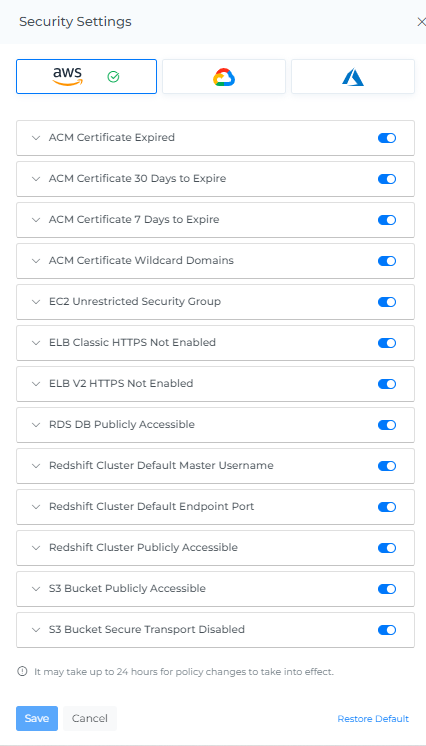

Reload Option
The "reset" option allows you to clear all filters and selections from the page, returning it to the default view. This can be useful if you want to start over or view the data in its original form.
Info
The "last updated" date and time stamp show when the data on the page was last refreshed. This can be useful for understanding the age of the data and determining if it is up to date.
Help
If you click on the "?" icon, you can access the help documentation for the page. This can provide you with additional information and guidance on using the page and its features.
